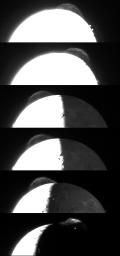Tvashtar Composite
Caption:
Variations in the appearance of the giant plume from the Tvashtar volcano on Jupiter's moon Io are seen in this composite of the best photos taken by the New Horizons Long Range Reconnaissance Imager (LORRI) during its Jupiter flyby in late February-early March 2007.
New Horizons was fortunate to witness this unusually large plume during its brief Jupiter flyby; the Galileo Jupiter orbiter spent more than five years imaging the volcanic moon (between 1996 and 2001) without ever capturing such detailed pictures of a large Io plume. The plume is roughly 330 kilometers (200 miles) high. The cause of the fine wispy structure in the plume, which varies strikingly from image to image, is unknown, but these pictures may help scientists to understand the phenomenon.
The pictures were taken at distances ranging from 3.1 to 2.3 million kilometers (1.9 to 1.4 million miles), but they have been scaled to show the plume at the same relative size in every frame. Illumination conditions also vary: in the final image, Io's shadow cuts across the plume and hides all but its topmost regions, and the glow of hot lava can be seen on the nightside at the source of the plume. The times of the images, from top to bottom, are: February 26, 18:38 (Universal Time); February 26, 21:01; February 28, 03:50; February 28, 04:40; February 28, 11:04; and March 1, 00:35.
Cataloging Keywords:
| Name |
Value |
Additional Values |
| Target |
Io |
Jupiter |
| System |
Jupiter |
|
| Target Type |
Satellite |
Planet |
| Mission |
New Horizons |
Galileo |
| Instrument Host |
New Horizons |
Galileo Orbiter |
| Host Type |
Flyby Spacecraft |
Orbiter |
| Instrument |
Long Range Reconnaissance Imager (LORRI) |
|
| Detector |
|
|
| Extra Keywords |
Grayscale, Plume, Shadow, Visual, Volcano |
| Acquisition Date |
|
| Release Date |
2007-05-01 |
| Date in Caption |
|
|
| Image Credit |
NASA/Johns Hopkins University Applied Physics Laboratory/Southwest Research Institute |
| Source |
photojournal.jpl.nasa.gov/catalog/PIA09359 |
| Identifier |
PIA09359 |

 Planetary Data System
Planetary Data System
